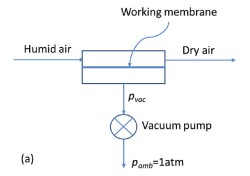Background
For my second and third co-op terms, I worked at Evercloak, a company that produces graphene-oxide (GO) membranes. Graphene refers to a single sheet of graphite, so the material is essentially a two-dimensional nano-film. I worked on the "applications" team, which investigated the various applications of these membranes. While I was there, I used the water vapour selective properties of the membranes to design a vacuum-based dehumidification system. However, most of the work that I did was confidential, so I can only describe some of the published aspects, omitting the required details.
Theory
Vacuum-based Membrane Dehumidification (VMD) works by passing a humid airstream over a water vapour selective membrane. A vacuum is applied to the other side of the membrane, and water vapour can be pulled directly from the humid airstream. The drier air is then returned to the room, while the water vapour is pumped outside. In this type of system, the only energy consumption comes from the vacuum pump, as compared to a traditional dehumidifier, in which energy is spent cooling the air below the dew point before heating it to normal temperatures. Vacuum pump sizing is limited by the water vapour capacity in this scenario, so one way to improve efficiency is to passively condense out as much water vapour as possible.

From Test Cell, to Industrial Unit
Based on this theory, and past small-scale experiments, I designed a test cell which used six times more membrane area than previous set-ups. This test cell was also significantly lighter and more scalable than previous designs, which meant that the full-scale unit would also use this design. I used Autodesk Inventor to create the design, and then produced drawings which were sent out to a machine shop for manufacturing. During this process, I worked with the machinists to include some features which would make machining easier, and produce less material waste. I also built the unit when the machining was complete, which allowed me to find some improvements that could make assembly easier. To test the system, Evercloak commissioned a Siemens PLC to be configured to control the inlet conditions, and also take data from the inlet, outlet, and vacuum side of the system. I spent a significant amount of time running tests, which allowed me to gain information which was useful while making changes to the design of the full-scale unit.
In my second term at Evercloak, my biggest task was to improve the production process of a certain key component. By tweaking this process and designing jigs to make it easier, I managed to reduce the production time by 28%, as well as improve the longevity of the entire system. Once the process was finalized, I created an SOP, and manufactured all of these components for the full-scale unit. The full-scale unit was industrial sized and used 10 times more membrane area than the test cell. Because of supply chain delays however, there were some pieces that we were not able to get in time for the end of my co-op. For this reason, I agreed to come back part-time during school, to finish assembling and testing the full scale unit. This larger unit was also in a location where it could be run 24h per day, so we allowed it to run for several months, and observed that performance and efficiency exceeded what we had seen in the test cell. One of the reasons for this is because the vacuum pumps become more efficient as they become larger.
Conclusion
This was a fantastic set of co-ops, as it was really rewarding to bring this VMD project from small-scale test cells to an industrial size unit. I learned a lot about design for manufacturing and design optimization that I will be able to apply in all my future designs. I also learned how to design for and work with rapid prototyping tools such as 3D-printers, laser-cutters, and machine shop tools. The reason I returned for a second co-op was to continue on the project I started, but I also was happy to continue working in a great environment with great resources and coworkers. I fully enjoyed my time at Evercloak and it has been a significantly positive influence on my engineering career.